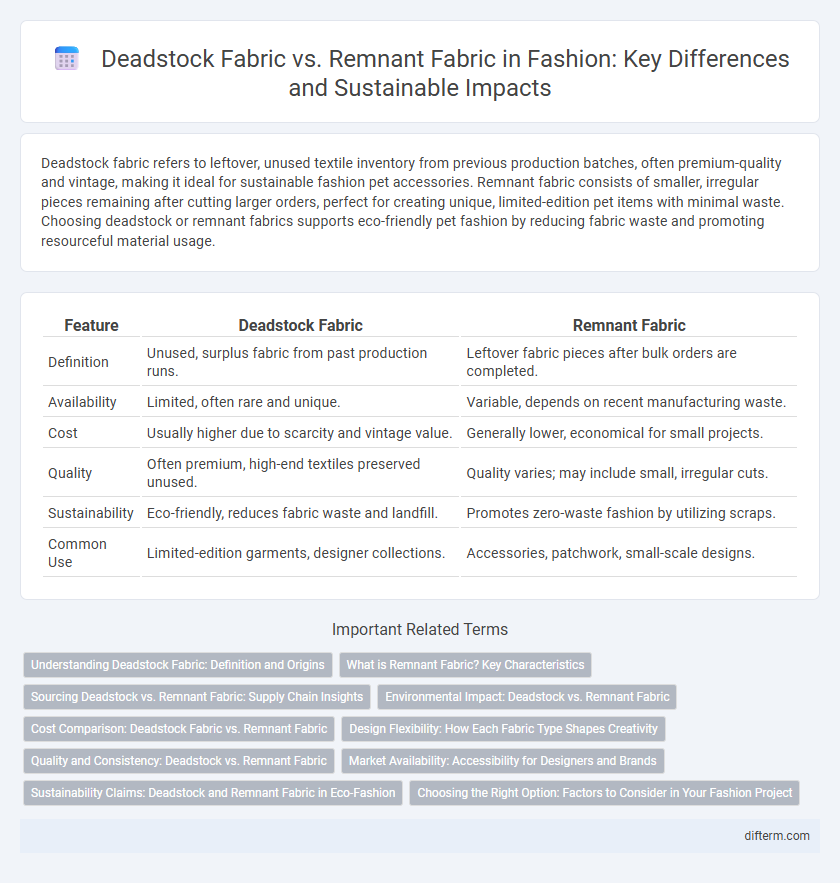Deadstock fabric refers to leftover, unused textile inventory from previous production batches, often premium-quality and vintage, making it ideal for sustainable fashion pet accessories. Remnant fabric consists of smaller, irregular pieces remaining after cutting larger orders, perfect for creating unique, limited-edition pet items with minimal waste. Choosing deadstock or remnant fabrics supports eco-friendly pet fashion by reducing fabric waste and promoting resourceful material usage.
Table of Comparison
| Feature | Deadstock Fabric | Remnant Fabric |
|---|---|---|
| Definition | Unused, surplus fabric from past production runs. | Leftover fabric pieces after bulk orders are completed. |
| Availability | Limited, often rare and unique. | Variable, depends on recent manufacturing waste. |
| Cost | Usually higher due to scarcity and vintage value. | Generally lower, economical for small projects. |
| Quality | Often premium, high-end textiles preserved unused. | Quality varies; may include small, irregular cuts. |
| Sustainability | Eco-friendly, reduces fabric waste and landfill. | Promotes zero-waste fashion by utilizing scraps. |
| Common Use | Limited-edition garments, designer collections. | Accessories, patchwork, small-scale designs. |
Understanding Deadstock Fabric: Definition and Origins
Deadstock fabric refers to unused, surplus textile materials from previous production runs or seasons, often stored in warehouses or fabric mills. These fabrics are typically high-quality, discontinued designs that brands no longer produce but remain available in limited quantities. Utilizing deadstock fabric supports sustainable fashion by reducing waste and preserving unique, rare textile patterns.
What is Remnant Fabric? Key Characteristics
Remnant fabric refers to leftover pieces of textile from production runs, typically smaller, irregularly shaped cuts that are sold at discounted prices. Key characteristics include limited quantities, varied sizes, and potential for unique, one-of-a-kind projects due to its leftover nature. This fabric type is favored for sustainable fashion efforts by reducing waste and offering affordable material options.
Sourcing Deadstock vs. Remnant Fabric: Supply Chain Insights
Deadstock fabric refers to unused, surplus textile inventory from past production runs, often sourced directly from mills or manufacturers, ensuring high-quality, fresh stock with minimal environmental impact. Remnant fabric consists of leftover pieces from cutting floors or production lines, typically smaller and more irregular in size, often acquired through wholesalers or end-of-roll sales. Sourcing deadstock fabric provides consistent material quality and unique vintage aesthetics, while remnant sourcing offers cost-effective options but may require more precise planning to maximize fabric utilization.
Environmental Impact: Deadstock vs. Remnant Fabric
Deadstock fabric significantly reduces environmental waste by repurposing unused bolts of fabric destined for landfill, minimizing production resource consumption and carbon emissions. Remnant fabric, while also eco-friendly, typically consists of smaller leftover pieces from production runs, leading to less efficient usage and more offcut waste. Choosing deadstock fabric prioritizes sustainable fashion by conserving raw materials and reducing textile industry pollution.
Cost Comparison: Deadstock Fabric vs. Remnant Fabric
Deadstock fabric typically commands a higher price due to its rarity and unused condition, often sourced from excess production runs of prestigious brands. Remnant fabric, sourced from leftover scraps or small cuts, tends to be more affordable, offering budget-friendly options for designers with limited project scopes. Cost efficiency depends on project scale, with deadstock providing premium quality for higher investment and remnants favoring economical, small-batch production.
Design Flexibility: How Each Fabric Type Shapes Creativity
Deadstock fabric offers expansive design flexibility by providing unique, often vintage patterns and textures that inspire exclusive, limited-edition fashion pieces. Remnant fabric, composed of smaller leftover cuts, challenges designers to innovate within size constraints, fostering creativity through patchwork and mixed-media designs. Both fabric types shape creativity by encouraging sustainable practices and distinctive aesthetic choices in fashion design.
Quality and Consistency: Deadstock vs. Remnant Fabric
Deadstock fabric, sourced from unused surplus rolls of high-quality material, offers superior consistency and pristine condition compared to remnant fabric, which consists of leftover patches from production runs with varying quality and patterns. The uniformity of deadstock ensures reliable texture and color across projects, making it ideal for designers seeking premium, consistent results. Remnants, while cost-effective, often require additional sorting and testing, as variations in fabric weight and finish can affect the final product's durability and appearance.
Market Availability: Accessibility for Designers and Brands
Deadstock fabric offers limited availability as it comprises surplus or discontinued materials, often sold in small quantities, making it a rare find for designers seeking exclusivity. Remnant fabric, sourced from leftover cuts after production, provides more accessible, affordable options with variable quantities, appealing to emerging brands and sustainable fashion initiatives. The market availability of deadstock fabric creates a competitive niche, while remnant fabric supports broader accessibility and creative experimentation in garment production.
Sustainability Claims: Deadstock and Remnant Fabric in Eco-Fashion
Deadstock fabric consists of unused, surplus textile inventory from production runs, offering a sustainable alternative by preventing waste and reducing the demand for new textile manufacturing. Remnant fabric refers to leftover materials from cutting processes, often smaller in size, which can be repurposed to minimize landfill contributions and resource consumption. Both fabrics support eco-fashion initiatives by promoting circularity and lowering the environmental footprint associated with traditional fabric sourcing.
Choosing the Right Option: Factors to Consider in Your Fashion Project
Choosing between deadstock fabric and remnant fabric hinges on project scale, budget, and sustainability goals; deadstock fabric offers high-quality, unused material often sourced from excess inventory, making it ideal for small batch production and eco-conscious designers. Remnant fabric, typically leftover pieces from larger production runs, tends to be more affordable and suitable for patchwork, accessories, or sample making where smaller quantities suffice. Evaluating fabric availability, texture consistency, and color matching plays a critical role in selecting the right option to enhance design cohesion and minimize waste.
Deadstock fabric vs Remnant fabric Infographic

 difterm.com
difterm.com